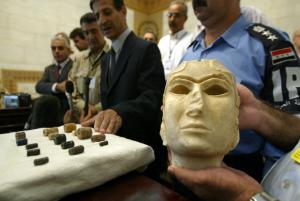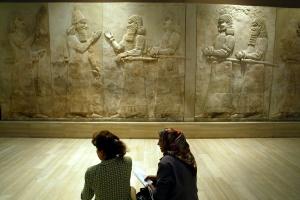Issue Date: October 17, 2003
International whodunit lingers over looting of Iraq's National Museum in Baghdad By FRANCIS DEBLAUWE The Iraq War is over; long live the Iraq War? If only it were that simple. Wars are brutal, cruel and most often, if not always, unjustified, and their aftermaths are equally problematic: a painful picking up of shattered pieces, many of which cannot be put together again, for better or for worse. The havoc wrought on the National Museum in Baghdad, provincial archaeological museums and archaeological sites at the end of the formal war in Iraq is symbolic of what Iraq as a whole suffered. Conflicting accounts in the media of what occurred at these museums have left many people confused about the scale of the losses and the responsibility for them. As early as last January, scholars and antiquities experts met with officials at the Pentagon to alert them to the threat to the archaeological and cultural heritage of Iraq in the event of war. The U.S. military was handed a list of important sites to avoid in combat, including the National Museum in Baghdad. It was also warned specifically about looting of museums, such as happened after the 1991 Gulf War. To their credit, in the early phase of the Iraq War the U.S. and British air attacks avoided the National Museum. Then, on April 8, the U.S. Marines on the ground ran into some resistance from Iraqi paramilitary forces that had sought refuge on the grounds of the museum. The museum staff had been trying to keep the museum safe but was at that time forced to flee. Knowing that the U.S. soldiers would be reluctant to use great force under those circumstances, the paramilitaries held out for a while. They took some positions inside and on top of the museum, but the U.S. military was still able to eliminate and chase them off. The U.S. soldiers left the museum complex unprotected and moved on to other fighting. Starting April 10, an armed mob proceeded to loot the museum for about three days. Those museum staff who had returned were powerless to stop them. Attempts were made by both staff and journalists to get Marines who were about 50 yards away to move a tank and secure the museum, but save for one tank crew that did so for half an hour on their own authority, the standard reply was that the soldiers did not have orders to do so. Museum officials braved the dangerous streets of Baghdad to go to the U.S. Marine headquarters in the Palestine Hotel, receiving assurances of protection for the museum. Two days went by with no tanks in sight. It was feared that looters would set fire to the museum. Museum staff finally was able to call the British Museum in London via a borrowed satellite phone and, soon after, the Marines showed up. It was April 16. In the aftermath of these unfortunate events, some in the Pentagon have claimed that they were not informed about the museum being important, that the looting was unexpected, that the initial panicked assessments of the damage at the museum were overstated to the point of near-total lies: All of this is untrue. To a certain extent, a blame game has been played by all sides involved: U.S. military, U.S. civil administration, Western, Iraqi and other Arab politicians, the media, National Museum staff, archaeologists and antiquities dealers. Hyperbole and exaggeration, black-and-white portrayals of the different players were rampant. Counting the costs The U.S. military set up a task force, together with the FBI and Customs, that got busy establishing what was actually missing through crime scene work, tracking down organized and amateur looters through tips and intelligence, identifying and authenticating returned/recovered artifacts (about 3,400 so far). The task force is led by reservist Col. Matthew Bogdanos, an assistant Manhattan district attorney with a classics degree. Interpol and UNESCO are coordinating the efforts to stop the gangs that smuggle antiquities from trading the stolen pieces. An online database is being set up describing all missing artifacts. It appears that professional art thieves, perhaps with some inside help, likely had a hand in at least some of the thefts, since some secure storage areas of the museum were accessed with keys. Also, some looters were very knowledgeable in stealing only highly valuable authentic artifacts and skipping good copies and knew their way around the labyrinthine underground structures of the museum well enough to locate valuable and highly portable artifacts such as a precious collection of cylinder seals. Interestingly, those looters who appear to have had inside knowledge of the museum apparently did not have the most up-to-date information about where objects were stored -- hence the safety of the museum’s treasured cuneiform tablets. Opportunistic small-time looters then took off with anything else that looked likely to fetch money. Some conservative politicians in this country were convinced that the Ba’ath party apparatchiks among the museum staff totally overstated if not lied about the losses to make the United States look bad, or organized the thefts and looting themselves to enrich themselves one last time. Regarding the overstatement of losses, it is true that the initial number of 170,000 artifacts reported missing was in error. The many years of working in a police state and not trusting anyone had left their mark: The precautionary measure of putting nearly 8,400 pieces from the museum’s public galleries in storage in a secret vault under the museum was kept a secret from almost all staff as well as U.S. authorities for a considerable period. The museum was also understaffed, and, as with many museums, a detailed, up-to-date inventory of the holdings was more an ideal than a reality. Some in the scholarly community in the West, as upset as their colleagues in Baghdad, appear to have thrown caution to the wind, especially when dealing with the media, who tend to focus on whatever is sensational and forget about expressed nuances and disclaimers. We should not come down too hard on Mesopotamian scholars, however, as they are hardly accustomed to the glare of the spotlight. The community of art and antiquities dealers reacted rather well, notwithstanding scattered evidence that some are all too willing to close their eyes to dubious provenances of traded antiquities. In the meantime, the enormous confusion about the extent of the losses from looting at the National Museum has subsided somewhat. What is the damage?
The holdings (501,000 total) of the National Museum can be categorized as follows: First, there were the artifacts in the public galleries, mainly the largest, heaviest ones that could not be removed for safekeeping, for example, Neo-Assyrian guardian sculptures; they numbered in the hundreds. A second group consisted of a few thousand valuable artifacts from the museum, especially the public galleries, that were stored in a secret location and in the vaults of the Central Bank, for example, the Treasure of Nimrud, a collection of gold and silver jewelry dating from the ninth or eighth century B.C. excavated from Nimrud, and the original gold bull’s head of the Lyre of Ur. A third category, the artifacts not on display but in the museum storage areas, made up the bulk of the museum collection. Some in the media downplayed the number of missing artifacts to around 20 or 30, omitting that this only reflected the losses in the public gallery. Current reports indicate that 29 artifacts from this group are still missing. When the museum staff led the U.S. authorities to the artifacts of Group 2, they were found to be safe. However, Group 3 still has thousands missing, among others the exquisite cylinder-seal collection (about 4,800 pieces). The museum staff is still crosschecking the artifacts with the inventories. The total number of missing artifacts currently stands at 10,000 (about 2 percent of the total collection) and may still climb. The 170,000 number initially cited by the media turned out to be the number of inventory entries in the museum. However, the same inventory number was often applied to more than one object. For instance, grave items from the same tomb would all be under the same inventory number. Restoring and preserving artifacts damaged as a result of being stored off site or vandalized will be time- and labor-consuming and, above all, costly; I estimate that about 4 percent of the collection may need expert care. Outside Baghdad, some of the famed centers of civilization in ancient Sumer (for example, Isin, Umma, Larsa) now look like moon landscapes, full of craters left by illicit digging. In the north, the old Assyrian capitals of Nineveh and Calah (Nimrud) were also targeted. Overall, about 40 well-known sites are now being protected by U.S. military; however, many more sites that have not been scientifically researched as extensively have and are being trashed and plundered. Like pages from a history book, they are ripped out before anyone has the chance to read them. Looters also stormed the provincial and archaeological site museums at Babylon, Mosul, Hatra, Basra and elsewhere. Why does it matter, beyond an in-crowd of art historians and archaeologists, whether only a few or tens of thousands of trinkets have been lost? Mesopotamia, the “Land between the Two Rivers,” the Tigris and the Euphrates (roughly present-day Iraq and northern Syria), is veritably the “Cradle of Civilization.” Writing was invented here (Sumerian cuneiform), as were the 24 hours of the day, law codes, cities, astronomy and more: in other words, civilization as we know it. In a sense, all Westerners and by extension the world community are the heirs of the Sumerians. Furthermore, any country of a certain size combines people with different religious, ethnic, linguistic, cultural and/or racial heritages. Looking back into the shared past helps to relativize some of the rivalries. Divisions have always existed but they keep on shifting: Groups of people split and unite; territories fragment and become one. The full archaeological/historical record shows the ultimate futility of narrow and selfish projects of exclusionary groups of people. Surely, in the 21st century we ought to know better. Iraq’s cultural heritage belongs to all humankind; hence it should be preserved and kept accessible to all, not locked away and scattered in private collections, never to be seen or studied in context by hardly anyone. Some things are too valuable to be treated as commodities sold to the highest bidder. Francis Deblauwe is a Mesopotamian archaeologist who maintains the 2003 Iraq War and Archaeology Web site. For an account of the sources used for this article, see the Web site at cctr.umkc.edu/user/fdeblauwe/iraq.html
National Catholic Reporter, October 17, 2003 |

